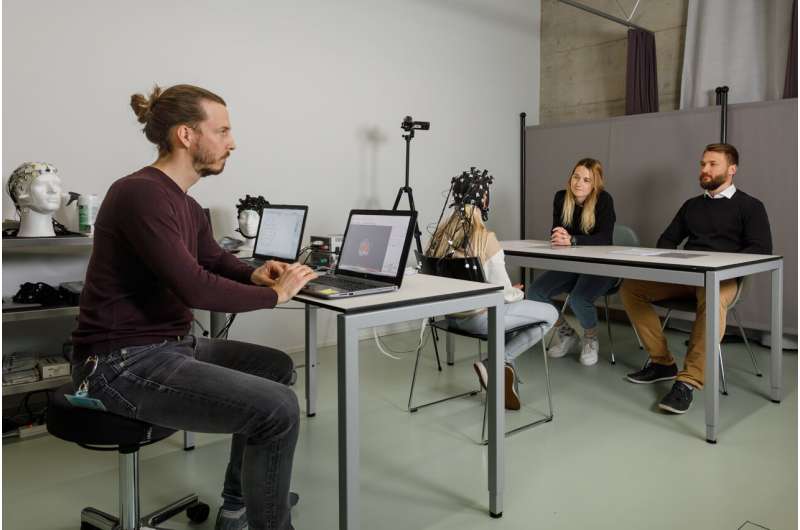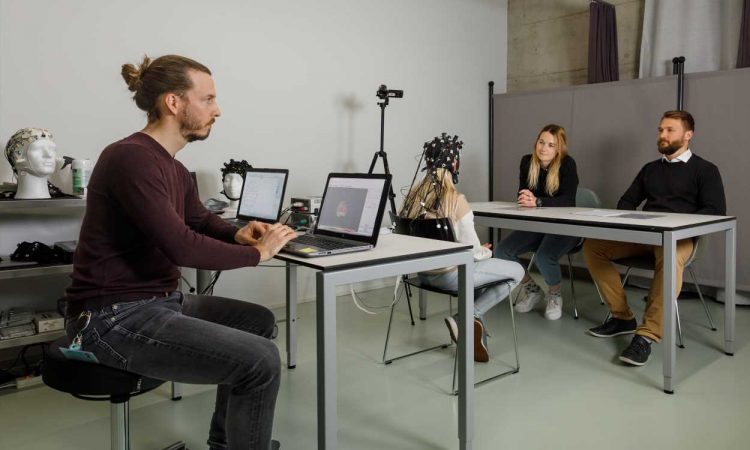
“Get some exercise.” It’s one suggestion adults frequently hear when they complain about stress in their lives. Exercise helps relieve stress. But does this also apply to children? Does exercise help them manage the pressures to achieve at school?
A research team led by Dr. Manuel Hanke and Dr. Sebastian Ludyga from the Department of Sport, Exercise and Health recently examined the effect of physical activity on children’s stress levels. Their findings appear in the Journal of Science and Medicine in Sport.
For their study, they had 110 children between the ages of 10 and 13 wear a sensor tracking their daily movement over the course of a week. They then brought the participants into the lab on two separate occasions to complete a stressful task and a non-stressful control task (see the box). The researchers tested the children’s physical stress reaction via the concentration of the stress hormone cortisol in their saliva.
Less cortisol in active children
“We wanted to determine whether physical activity makes children more resilient under laboratory-controlled circumstances,” explains project director Sebastian Ludyga. The results showed that the participants who got more than an hour of exercise per day, as the World Health Organization (WHO) recommends, did in fact produce less cortisol in the stress task than the children who were less active.
“Regularly active children seem to have a reduced physiological stress reaction in general,” notes Manuel Hanke, lead author of the study. Even in the control task, which involved an unfamiliar situation, making it still somewhat unsettling for the participants, there was a difference in cortisol levels between more and less active children—though overall cortisol levels were lower than in the stress task.
Stress hormone levels increase during exercise
One possible explanation for this finding could be that cortisol levels also increase during exercise, says Sebastian Ludyga. “When children regularly run, swim, climb, etc., the brain learns to associate a rise in cortisol with something positive. The body’s reaction always has a cognitive component as well: this positive association helps to prevent the concentration of cortisol from rising to too high a level in exam situations as well.”
Besides their analysis of the saliva samples, the researchers also examined cognitive reactions to the stress task by recording participants’ brainwaves via electroencephalogram (EEG). The team plans to analyze these data next. “Stress can interfere with thinking. Some of us are familiar with this in its most extreme form—a blackout,” Hanke explains. The team now aims to determine whether physical activity also has an influence on these cognitive effects of stress.
For their study, the researchers used the Trier Social Stress Test for Children: the participants had to read a story with an open ending, then had five minutes to prepare before using their notes to tell the rest of the story for a jury. What they didn’t know in advance was that the preparation time was intentionally kept so short so that it would not be sufficient.
After about a minute, their notes were mostly exhausted but they still had to fill five minutes and think something up on the spur of the moment. This task was followed by a seemingly simple arithmetic task in which participants were asked to repeatedly reduce a number in the high three digits by a certain value over the course of five minutes.
The stress in this task is primarily caused by errors, which require the participant to restart the task from the beginning. In the control task, which was conducted on a separate occasion, the children also had to read a story, but they then discussed general questions about the story with a researcher without any pressure to perform. In both sessions, the researchers took saliva samples at regular intervals before and after the tasks in order to measure cortisol levels.
More information:
Manuel Hanke et al, Moderate-to-vigorous physical activity and reactivity to acute psychosocial stress in preadolescent children, Journal of Science and Medicine in Sport (2023). DOI: 10.1016/j.jsams.2023.07.010
Journal information:
Journal of Science and Medicine in Sport
Source: Read Full Article
